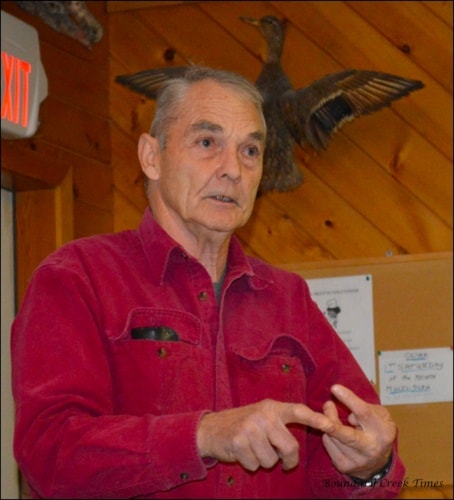An open season on whitetail does has local hunters concerned about the resource. The Kettle Wildlife Association sponsored a meeting at their wildlife hall in Rock Creek last Friday night that brought out nearly 50 to hear retired Grand Forks guide/ outfitter Barry Brandow speak out against the hunt.
The meeting was called to try to generate media attention and pressure on the government to shorten or stop the season on the whitetail doe because many of those at the meeting say that herd numbers are being rapidly depleted.
KWA president Ron Cooper opened the meeting and turned it over to Les Best who introduced Brandow who told the meeting that he is angry about what is happening to wildlife management province-wide. “In the Boundary it has literally been destroyed,” he stated.
“We have got a strong argument for change,” Brandow told the group. “A lot of you would be out there all day in your traditional hunting areas and not see a deer or a deer track.”
He said that people assume that if deer are in the fields or city lots that there is a relationship to what is on their historic range. “That’s a major problem.”
Brandow challenged the white tail doe season in 2010 when it was introduced. He has a webpage (www.wildlifeheritageforever.com) dating back to that time that has testimonials from several local hunters opposing the doe season.
Brandow still challenges the numbers. “If we don’t get media attention then we are in serious trouble.”
Brandow maintains that in management units 12, 14 and 15 of Region 8 the white tail doe season must be cut back or eliminated. Several people pointed out that when a doe is harvested it often means the death of her fawn(s) both that year and the lost opportunity for her to deliver another pair in the next year. So taking one doe actually can cut the herd by four or five animals as her fawns fall prey to predators or are killed on the highways.
“If we don’t show that we are stewards of the land the question is what animal will be next?” asked Brandow.
Ken Corfe, owner of Kodiak Sausage and Meats in Rock Creek, gave statistics on the number of deer that have come through his shop over the past four years. In 2010 he processed 107 deer. From 2011 on he also recorded the sex of the carcass so his numbers for 2011 are - 89 total deer, 31 per cent does, 2012 – 103 animals, 29 per cent does, and in 2013 - 73 carcasses, 26 per cent does.
“Not one hunter has come to my shop and said, ‘wow you have a lot of deer’,” said Corfe. “Every single person that came into my shop said there are no deer.”
Rock Creek resident Rick Riley said he can recall 20 years ago there would be a herd of 150 deer on the side hills above Midway.
“Now they count 20,” he told the crowd. “But when you go back into that high country they are not there.”
“Does anyone in this room support the three week whitetail doe season?” Brandow asked the room at one point?
No one challenged him.
Brandow said the province has a mule deer recovery program, which calls for the reduction in the white tail herd because it is felt that the white tail will become the dominant species in the area.
Citing a 1968 study entitled Boundary Deer Herd by Dave Spaulding, Brandow said the mule deer started to decline in the ’40s and the ’50s.
He said that today very few people go for a mule deer hunt. “You buy a tag and if you run into a mule deer you harvest it. That animal is in serious trouble and now, out of no-where we’ve got into the white tail doe season in 2010.”
“You are gambling that you can save the mule deer yet you are destroying the whitetail,” said Brandow. He argued that there should be an end to the mule deer doe draw. “If you are concerned about the mule deer getting better—the first thing you have got to do is get rid of that draw.”
Local resident Joey Walker who has been riding the Boundary backcountry for 43 years says the deer are gone.
“In my mind there is no question whatsoever the deer are gone,” she said. “This year I heard eight shots all season up in the hills.”
She disputes the claim that whitetail drive mule deer out. She encouraged the group to write letters.
Other hunting regulations were also challenged. Don Johnstone said archers are not happy that their bow season is shared with rifle hunters. And there were some calls to change the rule that allows hunting for one hour after sunset.
Ken Sward, BC Wildlife Federation (BCWF) Regional President for the Okanagan, was at the meeting. “The BCWF supports (hunting) opportunity based on sound science, and if it is not sound science we don’t support it.”
He supports the letter writing campaign and urged people to identify themselves as hunters in their letters. He said he had taken a few pages of notes and would report on this meeting to the next regional meeting.
“I respect what you guys say,” he declared.
Contacted via email on Monday Regional Biologist for the Ministry of Forests, Lands and Natural Resource Operations provided the Times with a copy of a fact sheet that came out in 2010 entitled White-tailed Deer: Provincially Coordinated Hunting. The paper states that, “If conservation concerns are identified, the Ministry will revise the regulations to ensure that the hunt remains sustainable.”
A follow-up meeting is planned for March 2014.
